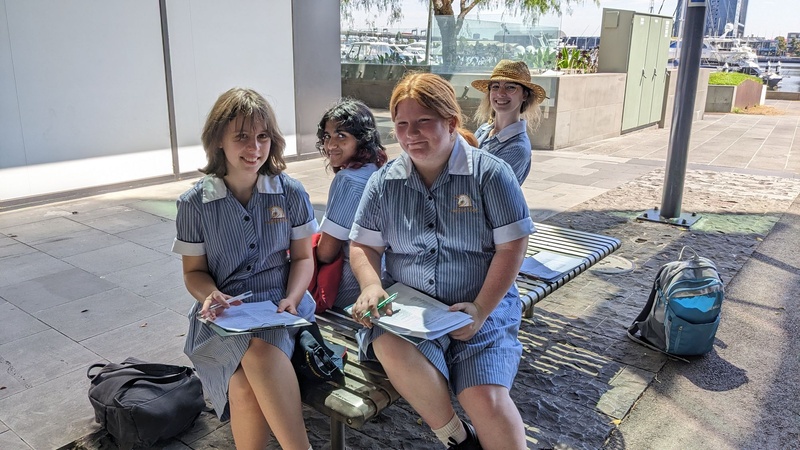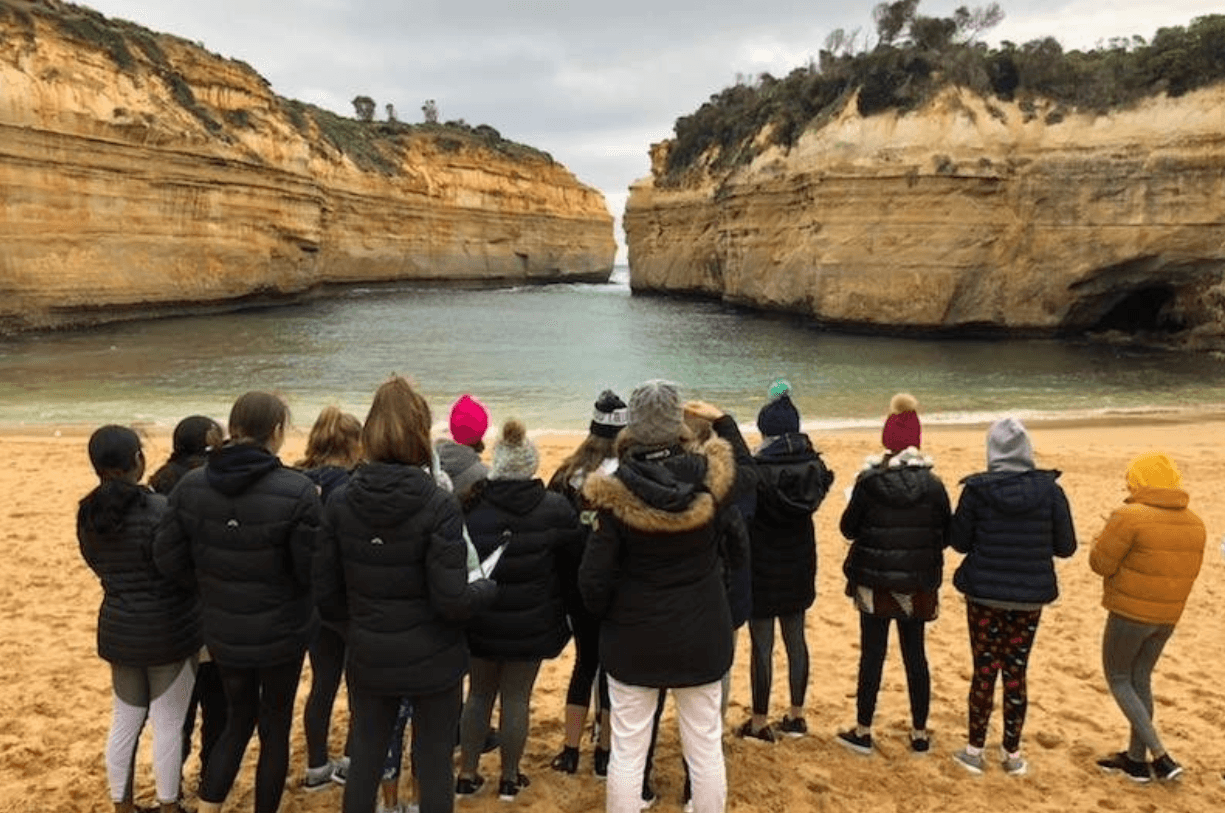Geography is a skill and vision that opens the door for learners to gain a deeper understanding of the interconnected world around them. By studying Geography we can develop the insight to draw connections, measure how individual actions can change the world, assess the costs and benefits, and seek effective solutions to the many complex issues facing our planet. As a discipline, Geography is uniquely positioned to tackle the challenges of the modern era.
The study of Geography is a structured way of exploring, analysing and understanding the characteristics of places that make up our world. Geographers are interested in key questions concerning places and geographic phenomena: What is there? Where is it? Why is it there? What are the effects of it being there? How is it changing over time and how could, and should, it change in the future? How is it different from other places and phenomena? How are places and phenomena connected? Students explore these questions through fieldwork and investigation of a wide range of secondary sources.
Studying Geography allows students to develop a unique framework for understanding the world, enabling them to appreciate its complexity, the diversity and interactions of its environments, economies and cultures, and the processes that helped form and transform them.
In VCE Geography, Key Geographical Concepts are used in the exploration of each area of study to assist in the observation, description, interpretation, analysis and explanation of geographic phenomena.
VCE Geography enables students to examine natural and human phenomena, how and why they change, their interconnections and the patterns they form across the Earth’s surface. In doing so, they develop a better understanding of their own place and its spaces and those in other parts of the world. These spatial perspectives, when integrated with historical, economic, ecological and cultural perspectives, deepen understanding of places, environments and human interactions with these.
HAZARDS AND DISASTERS
The world can be a dangerous place with a wide range of disasters and hazards affecting the lives of millions of people every year. Geographers have an important role to play in understanding these dangers and in helping people to prepare for them. In this unit students undertake an overview study of hazards before investigating two contrasting types of hazards. Students examine the processes involved with hazards and hazard events, including their causes and impacts, and interconnections between human activities and natural phenomena.
This unit also investigates how people have responded to specific types of hazards, including attempts to reduce vulnerability to, and the impact of, hazard events. Students explore the nature and effectiveness of specific measures such as prediction and warning programs, community preparedness and land use planning, as well as actions taken after hazards become harmful and destructive disasters. They study natural and human factors influencing the nature of human responses , considering the scale of the hazard, levels of risk due to hazards, past experiences and perceptions of similar hazards and hazard events, the economic choices available to government organisations and communities to take action, available technological resources and the ability to plan and develop effective prevention and mitigation measures.
Two hazards will be examined in detail. The first is the bushfire hazard in south-eastern Australia. The 2009 Black Saturday bushfires are studied in detail as a case study, culminating in a full-day field trip to the Kinglake Ranges to examine the causes, impacts and responses to these fires in this region. The contrasting study is of biological hazards such as the West African Ebola epidemic.
Assessment
A variety of learning activities and assessment tasks are used that provide a range of opportunities for students to demonstrate the key knowledge and key skills in the outcomes. For this unit students are required to demonstrate two outcomes. As a set these outcomes encompass the areas of study in the unit.
The core assessment is a fieldwork report of approximately 1500–2000 words.
Additionally, at least one task for the assessment of each of Outcomes 1 and 2 is to be selected from the following:
- structured questions
- a case study
- analysis of geographic data
- a multimedia presentation
TOURISM
In this unit students investigate the characteristics of tourism, with particular emphasis on where it has developed, its various forms, how it has changed and continues to change and its impacts on people, places and environments. Contrasting examples of tourism from within Australia and elsewhere in the world are studied to support their investigations.
The study of tourism at local, regional and global scales emphasises the interconnection within and between places. Students will explore the nature of tourism and the range of benefits to individuals, communities and nations. Students will also consider the significant negative impact on environments, economies and cultures that tourism brings. Geographers study these impacts and make recommendations about managing tourist numbers and activities to ensure environmentally sustainable and economically viable tourism.
Two case studies will be investigated in detail: a full day field trip to Phillip Island and the Penguin Parade will be undertaken to study the balance between tourism and the environment; this will be contrasted with an exploration of an overseas tourist destination such as Bali in Indonesia.
Assessment
A variety of learning activities and assessment tasks are used that provide a range of opportunities for students to demonstrate the key knowledge and key skills in the outcomes. For this unit students are required to demonstrate two outcomes. As a set these outcomes encompass the areas of study in the unit.
The core assessment is a fieldwork report of approximately 1500–2000 words.
Additionally, at least one task for the assessment of each of Outcomes 1 and 2 is to be selected from the following:
- structured questions
- a case study
- analysis of geographic data
- a multimedia presentation
CHANGING THE LAND
This unit focuses on two investigations of geographical change: change to land cover and change to land use. Land cover includes biomes such as forest, grassland, tundra and wetlands, as well as land covered by ice and water. Land cover is the natural state of the biophysical environment developed over time as a result of the interconnection between climate, soils, landforms and flora and fauna and, increasingly, interconnections with human activity. Natural land cover has been altered by many processes such as geomorphological events, plant succession and climate change. People have modified land cover to produce a range of land uses to satisfy needs such as housing, resource provision, communication, recreation and so on.
Students investigate two major processes that are changing land cover in many regions of the world:
- deforestation
- melting glaciers and ice sheets.
Students investigate the distribution and causes of these two processes. They select one location for each of the two processes to develop a greater understanding of the changes to land cover produced by these processes, the impacts of these changes and responses to these changes at different scales.
At a local scale students investigate land use change using appropriate fieldwork techniques and secondary sources. They investigate the scale of change, the reasons for change and the impacts of change.
Students undertake fieldwork and produce a fieldwork report.
Satisfactory completion
The award of satisfactory completion for a unit is based on whether the student has demonstrated the set of outcomes specified for the unit.
Assessment of levels of achievement
Students’ level of achievement in Unit 3 will be determined by School-assessed Coursework.
- Structured questions (approximately 50–60 minutes) 10%
- Fieldwork report (approximately 1500–2000 words) 50%
- Analysis of geographic data and a case study (approximately 50–60 minutes) 40%
Total marks available 100
Contribution to final assessment
School-assessed Coursework for Unit 3 will contribute 25% to the study score.
HUMAN POPULATIONS; TRENDS AND ISSUES
In this unit students investigate the geography of human populations. They explore the patterns of population change, movement and distribution, and how organisations and individuals have responded to those changes in different parts of the world.
Students undertake an overview of world population distribution and growth before investigating the dynamics of population change over time and space. Through the study of population dynamics students investigate growth and decline in fertility and mortality, together with population movements. Students study forced and voluntary, and internal and external, population movements and how they can be long term or short term.
Students then investigate two significant population trends arising in different parts of the world. Students will learn about some of the problems caused by the growth of populations as well as other problems such as ageing populations and even, in some countries, declining populations. They examine the dynamics of populations and their economic, social, political and environmental impacts on people and places. They also evaluate the effectiveness of strategies in response to these issues and challenges.
The study is supported with examples from within and between countries with different economic and political conditions and social structures that illustrate the dynamics of population.
Satisfactory completion
The award of satisfactory completion for a unit is based on whether the student has demonstrated the set of outcomes specified for the unit.
Assessment of levels of achievement
The student’s level of achievement in Unit 4 will be determined by School-assessed Coursework.
- Analysis of geographic data. 40%
- Case studies. 60%
Total marks available 100
Contribution to final assessment
School-assessed Coursework for Unit 4 contributes 25%.
External assessment
The level of achievement for Units 3 and 4 is also assessed by an end-of-year examination, which will contribute 50%.

Student Point of View
Valuable skills learnt in Geography, such as communication, analysis, critical-thinking, data visualisation and problem-solving skills are in high demand, not only in further education but also in the world beyond. Geography is particularly well supported by subjects from areas of the Sciences, Commerce such as Economics and Legal Studies, Humanities and Outdoor Education. The dynamic and evolving field of geospatial technologies including Geographic Information Systems (GIS) provides diverse opportunities for tertiary study and career development.
In VCE Geography students develop a range of skills, many of which employ spatial and digital technologies. Investigative skills develop students’ ability to conduct geographic study and inquiry including the collection of primary data through observation, surveys, fieldwork, and the collection of data and information from relevant secondary sources. Interpretative and analytical skills enable students to interpret information presented in a variety of formats including maps, graphs, diagrams and images. These skills encourage students to critically evaluate information for its validity and reliability. Presentation and communication skills enable students to communicate their knowledge and understanding in a coherent, creative and effective manner, with the use of appropriate geographic terminology.
“Geography truly is a subject that no matter your end goal, will provide assistance and help you better your own person. It enables an understanding of the world on a broader level and how we personally connect into it, aiding you into becoming a better global citizen.”
Studies in VCE GEOGRAPHY can lead to study and career options in the following areas:
Environmental Management:
For example: Architecture, Ecology, Surveying, Urban and Rural Planning, Cartography, Agriculture, Landscape Architecture, International Relations and Development, Resource Management
Science
For example: Environmental Science, Meteorology, Zoology, Oceanography, Ecology, Engineering, Archaeology, and Geology
Management and Administration
For example: Local Government, Sports Management, Human Resources, Environmental Consultancy, Occupational Health and Safety, Event Management
Business and Finance
For example: Law, Insurance, Banking, Marketing, Advertising, Real Estate, Small Business Management
Leisure, Travel and Tourism
For example: Travel Consultancy and Management, Pilot, Hotel Management, Tourism Departments, Photography, Flight Data Officer, Recreation Officer
Information Services
For example: Journalism, Publishing, Communications, Radio and Television, Systems Analyst, Statistician, Foreign Affairs, Property
Education and Social Services
For example: Social work, Teaching, Armed Forces, Police Force, Sociologist, Lecturer, Research Scientist




